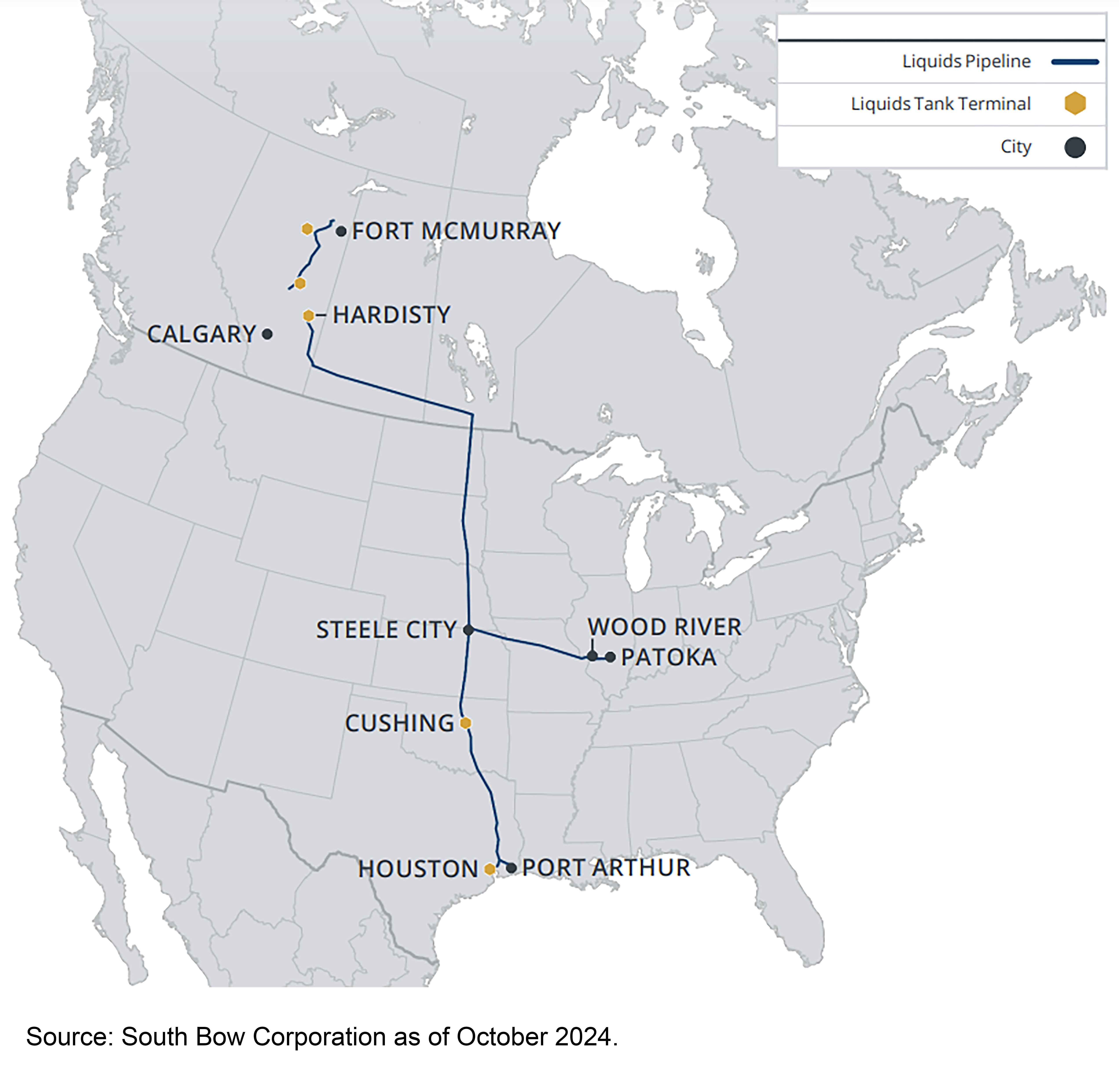Meet the New Canadian Name in Midstream
Midstream spinoffs from producer, utility, or refiner parents were common in the past, though the last example was DT Midstream (DTM) in 2021. This year saw a unique case of a midstream company splitting, with the spin of TC Energy’s (TRP CN) crude assets into South Bow Corporation (SOBO CN). Today’s note looks at SOBO’s asset portfolio and the company’s capital allocation strategy. It also looks at a diversified way investors can gain exposure to the new midstream name.
SOBO Spin-Off Overview
On Oct. 1, South Bow Corporation (SOBO CN) was spun off from TC Energy (TRP CN) and began trading on the Toronto Stock Exchange and the New York Stock Exchange. TRP maintains its extensive natural gas infrastructure, as well as its power and energy solutions businesses. SOBO includes oil infrastructure in the U.S. and Canada. The spin was intended to maximize shareholder value and allow the individual companies to execute on their distinctive growth opportunities, with natural gas generally seeing a wider opportunity set (read more).
The newly independent company currently has a market capitalization of CAD 7.4 billion. It has seen its share price rise over 22% as of Oct. 22 since its debut. The company is expecting to pay US $2.00 (CAD $2.75) per share in dividends annually, with SOBO yielding 7.7% as of Oct. 22.
Strong Asset Base Lends to Constructive Outlook
SOBO owns crude pipeline systems in the U.S. and Canada spanning over 3,000 miles and with approximately 1.25 million barrels per day (MMBpd) of capacity. The Keystone Pipeline System is the flagship asset and connects crude production in Canada and the U.S. with refineries in Illinois, Oklahoma, and Texas. The Marketlink system transports crude from the Cushing, Oklahoma oil hub to the Gulf Coast via Keystone’s Gulf Coast extension. In Alberta, SOBO operates the Grand Rapids and White Spruce pipeline systems that connect oil sands production to refining centers and export conduits. The company also operates related storage terminals in the U.S. and Canada.
The underlying contracts for these assets contribute to a constructive outlook for SOBO. Around 88% of SOBO’s EBITDA is based on long-term contracts with average remaining tenures of approximately eight years. The company’s customers mainly include refiners, producers, and other vertically integrated companies. Ninety-six percent of SOBO’s revenues coming from investment-grade companies. SOBO enjoys low-risk, highly contracted cash flows. That’s a clear benefit of the midstream business model.

SOBO’s Capital Allocation Strategy Prioritizes Debt Reduction
SOBO has outlined a clear strategy for capital allocation moving forward. The top priority is paying a sustainable base dividend. Beyond the dividend, the company is also focused on debt reduction. Over the next three years, the company aims to reduce net debt-to-comparable EBITDA by 0.25x-0.5x, with a long-term target of 4.0x. Currently, SOBO’s leverage ratio sits at 5.0x, and the company has an investment-grade credit rating (BBB-) from S&P.
SOBO is focused on growing earnings through modest capital investments as it targets 2%-3% long-term EBITDA growth. The company also plans to evaluate opportunistic buybacks. Management has indicated the dividend will not be increased until SOBO’s payout ratio is at desired lower levels, likely in four years. The first dividend of US $0.50 (CAD $0.69) per share for 4Q24 is expected to be announced by Nov. 7 and paid at the end of January 2025. Future dividends are expected to be declared in U.S. dollars.
How Do Investors Gain Exposure?
SOBO is a prime example of the integration in assets between Canada and the U.S. Given the commonality of asset ownership across the border, midstream indexes typically include U.S. and Canadian C-Corps.
The Alerian Midstream Energy Select Index (AMEI), which includes 75% U.S. and Canadian C-Corps, with the remaining 25% made up of midstream MLPs, has included SOBO since it began trading as an independent company.
The addition of SOBO brings AMEI to six Canadian constituents, with an aggregate weight of 25.9% as of Oct. 22. To be clear, because TRP is also a constituent of AMEI, SOBO’s asset base had already been included in the index. As of Oct. 22, TRP had a 4.9% weight in AMEI, while SOBO had a 0.53% weighting.
Related Research
AI, Natural Gas & Midstream’s Emerging Opportunities
AMEI is the underlying index for the Alerian Energy Infrastructure ETF (ENFR) and the Alerian Energy Infrastructure Portfolio (ALEFX).
Vettafi.com is owned by VettaFi LLC (“VettaFi”). VettaFi is the index provider for ENFR and ALEFX, for which it receives an index licensing fee. However, ENFR and ALEFX are not issued, sponsored, endorsed, or sold by VettaFi, and VettaFi has no obligation or liability in connection with the issuance, administration, marketing, or trading of ENFR or ALEFX.
For more news, information, and strategy, visit the Energy Infrastructure Channel.